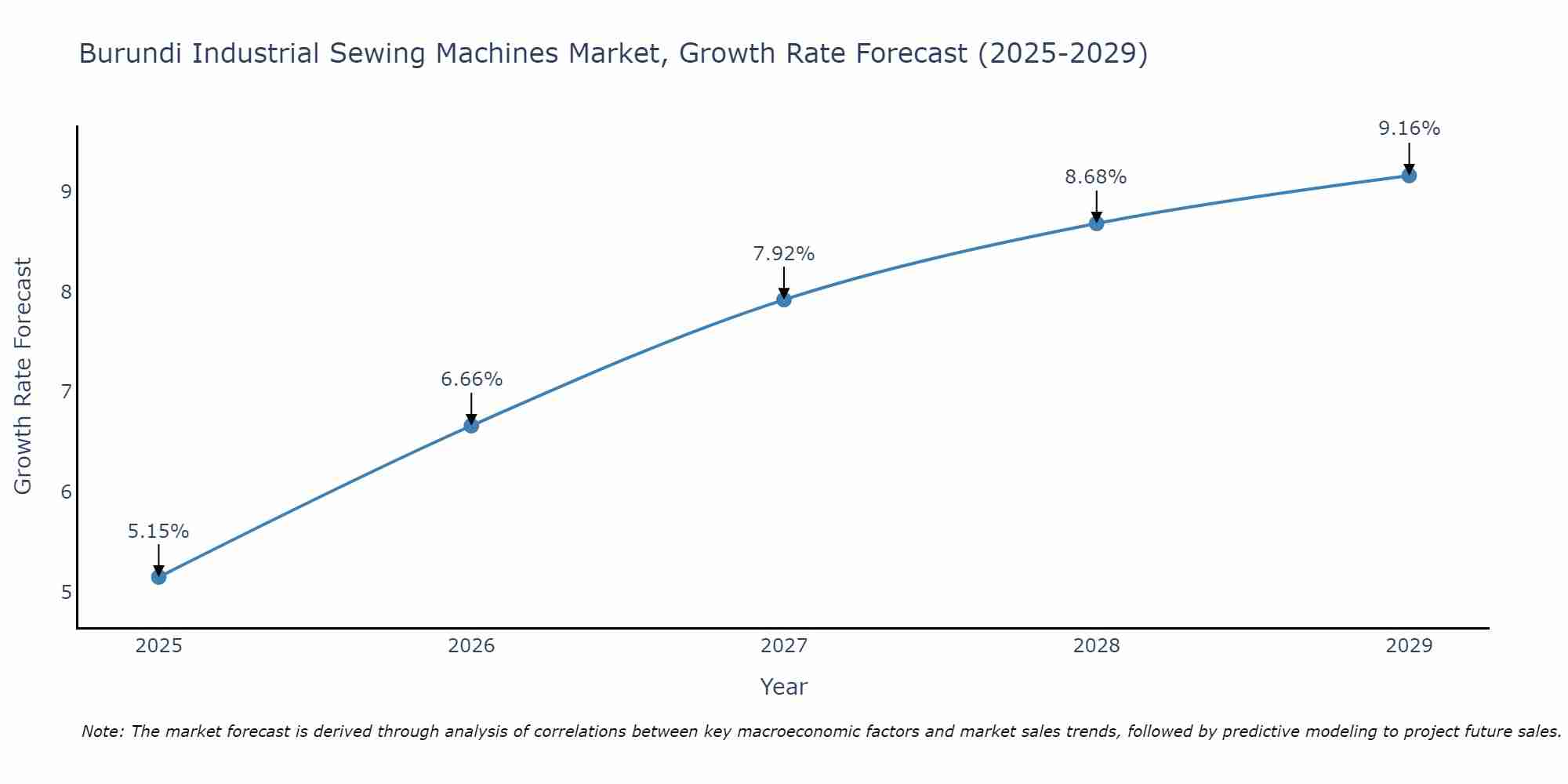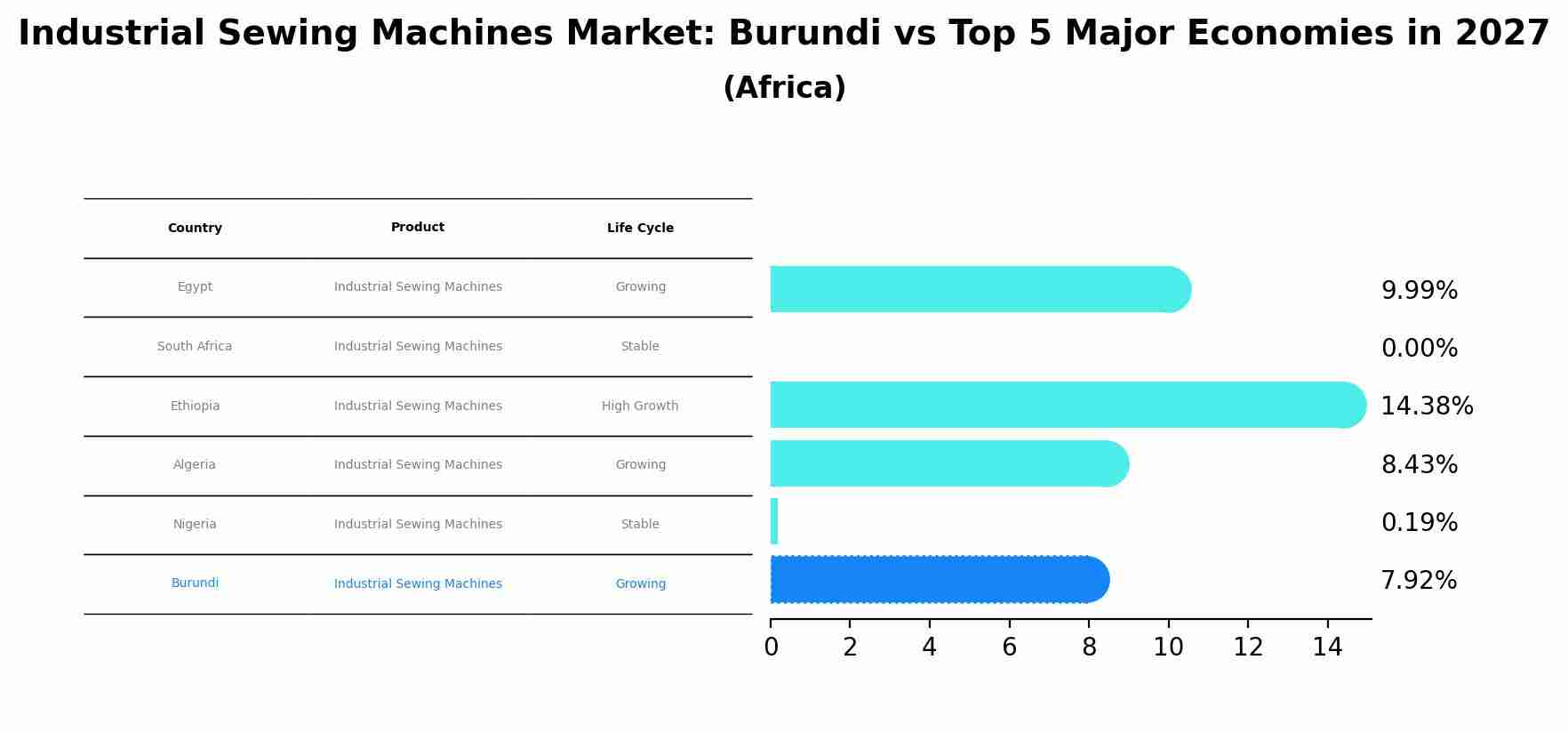Burundi Industrial Sewing Machines Market (2025-2031) | Companies, Outlook, Segmentation, Industry, Share, Revenue, Analysis, Forecast, Trends, Growth, Size & Value
| Product Code: ETC4742793 | Publication Date: Nov 2023 | Updated Date: Apr 2025 | Product Type: Market Research Report | |
| Publisher: 6Wresearch | Author: Shubham Deep | No. of Pages: 60 | No. of Figures: 30 | No. of Tables: 5 |
Burundi Industrial Sewing Machines Market Size Growth Rate
The Burundi Industrial Sewing Machines Market is likely to experience consistent growth rate gains over the period 2025 to 2029. The growth rate starts at 5.15% in 2025 and reaches 9.16% by 2029.

Industrial Sewing Machines Market: Burundi vs Top 5 Major Economies in 2027 (Africa)
Burundi's Industrial Sewing Machines market is anticipated to experience a growing growth rate of 7.92% by 2027, reflecting trends observed in the largest economy Egypt, followed by South Africa, Ethiopia, Algeria and Nigeria.

Burundi Industrial Sewing Machines Market Overview
The industrial sewing machines market in Burundi focuses on machinery used for sewing textiles and other materials in industrial settings. This market is driven by the needs of the garment and textile industries, where efficient and high-performance sewing machines are essential for mass production and quality control. Innovations in sewing technology and automation are key factors influencing this market.
/h3
The Burundi Industrial Sewing Machines Market is expanding due to the increasing need for high-performance sewing machines in the textile and apparel industry. Industrial sewing machines are used for mass production of garments, upholstery, and other textile products. The growth in the textile industry and the demand for efficient and durable sewing equipment drive market growth.
/h3
The industrial sewing machines market in Burundi is constrained by high import costs and a lack of local manufacturing facilities. Limited awareness of the advanced technologies and benefits of industrial sewing machines impacts market growth. Logistical challenges related to the import and distribution of sewing machines, combined with a shortage of skilled technicians for installation and maintenance, further hinder market development. Inadequate infrastructure affects the efficiency of sewing machine operations.
/h3
Government policies in Burundi affect the industrial sewing machines market by promoting the use of advanced machinery in textile and garment manufacturing. The government supports local production and investment in sewing machine technologies through regulations and incentives aimed at improving manufacturing efficiency and quality. These policies are designed to enhance the competitiveness of the textile industry, drive technological advancement, and support the growth of the industrial sewing machine market.
Key Highlights of the Report:
- Burundi Industrial Sewing Machines Market Outlook
- Market Size of Burundi Industrial Sewing Machines Market, 2024
- Forecast of Burundi Industrial Sewing Machines Market, 2031
- Historical Data and Forecast of Burundi Industrial Sewing Machines Revenues & Volume for the Period 2021-2031
- Burundi Industrial Sewing Machines Market Trend Evolution
- Burundi Industrial Sewing Machines Market Drivers and Challenges
- Burundi Industrial Sewing Machines Price Trends
- Burundi Industrial Sewing Machines Porter`s Five Forces
- Burundi Industrial Sewing Machines Industry Life Cycle
- Historical Data and Forecast of Burundi Industrial Sewing Machines Market Revenues & Volume By Fabric Weight for the Period 2021-2031
- Historical Data and Forecast of Burundi Industrial Sewing Machines Market Revenues & Volume By Lightweight for the Period 2021-2031
- Historical Data and Forecast of Burundi Industrial Sewing Machines Market Revenues & Volume By Medium Weight for the Period 2021-2031
- Historical Data and Forecast of Burundi Industrial Sewing Machines Market Revenues & Volume By Heavy Weight for the Period 2021-2031
- Historical Data and Forecast of Burundi Industrial Sewing Machines Market Revenues & Volume By Extra-heavy Weight for the Period 2021-2031
- Historical Data and Forecast of Burundi Industrial Sewing Machines Market Revenues & Volume By Bed Type for the Period 2021-2031
- Historical Data and Forecast of Burundi Industrial Sewing Machines Market Revenues & Volume By Flat Bed for the Period 2021-2031
- Historical Data and Forecast of Burundi Industrial Sewing Machines Market Revenues & Volume By Cylinder Bed for the Period 2021-2031
- Historical Data and Forecast of Burundi Industrial Sewing Machines Market Revenues & Volume By Post Bed for the Period 2021-2031
- Historical Data and Forecast of Burundi Industrial Sewing Machines Market Revenues & Volume By Application for the Period 2021-2031
- Historical Data and Forecast of Burundi Industrial Sewing Machines Market Revenues & Volume By Apparel for the Period 2021-2031
- Historical Data and Forecast of Burundi Industrial Sewing Machines Market Revenues & Volume By Non-apparel for the Period 2021-2031
- Burundi Industrial Sewing Machines Import Export Trade Statistics
- Market Opportunity Assessment By Fabric Weight
- Market Opportunity Assessment By Bed Type
- Market Opportunity Assessment By Application
- Burundi Industrial Sewing Machines Top Companies Market Share
- Burundi Industrial Sewing Machines Competitive Benchmarking By Technical and Operational Parameters
- Burundi Industrial Sewing Machines Company Profiles
- Burundi Industrial Sewing Machines Key Strategic Recommendations
Frequently Asked Questions About the Market Study (FAQs):
1 Executive Summary |
2 Introduction |
2.1 Key Highlights of the Report |
2.2 Report Description |
2.3 Market Scope & Segmentation |
2.4 Research Methodology |
2.5 Assumptions |
3 Burundi Industrial Sewing Machines Market Overview |
3.1 Burundi Country Macro Economic Indicators |
3.2 Burundi Industrial Sewing Machines Market Revenues & Volume, 2021 & 2031F |
3.3 Burundi Industrial Sewing Machines Market - Industry Life Cycle |
3.4 Burundi Industrial Sewing Machines Market - Porter's Five Forces |
3.5 Burundi Industrial Sewing Machines Market Revenues & Volume Share, By Fabric Weight, 2021 & 2031F |
3.6 Burundi Industrial Sewing Machines Market Revenues & Volume Share, By Bed Type, 2021 & 2031F |
3.7 Burundi Industrial Sewing Machines Market Revenues & Volume Share, By Application, 2021 & 2031F |
4 Burundi Industrial Sewing Machines Market Dynamics |
4.1 Impact Analysis |
4.2 Market Drivers |
4.3 Market Restraints |
5 Burundi Industrial Sewing Machines Market Trends |
6 Burundi Industrial Sewing Machines Market Segmentations |
6.1 Burundi Industrial Sewing Machines Market, By Fabric Weight |
6.1.1 Overview and Analysis |
6.1.2 Burundi Industrial Sewing Machines Market Revenues & Volume, By Lightweight, 2021-2031F |
6.1.3 Burundi Industrial Sewing Machines Market Revenues & Volume, By Medium Weight, 2021-2031F |
6.1.4 Burundi Industrial Sewing Machines Market Revenues & Volume, By Heavy Weight, 2021-2031F |
6.1.5 Burundi Industrial Sewing Machines Market Revenues & Volume, By Extra-heavy Weight, 2021-2031F |
6.2 Burundi Industrial Sewing Machines Market, By Bed Type |
6.2.1 Overview and Analysis |
6.2.2 Burundi Industrial Sewing Machines Market Revenues & Volume, By Flat Bed, 2021-2031F |
6.2.3 Burundi Industrial Sewing Machines Market Revenues & Volume, By Cylinder Bed, 2021-2031F |
6.2.4 Burundi Industrial Sewing Machines Market Revenues & Volume, By Post Bed, 2021-2031F |
6.3 Burundi Industrial Sewing Machines Market, By Application |
6.3.1 Overview and Analysis |
6.3.2 Burundi Industrial Sewing Machines Market Revenues & Volume, By Apparel, 2021-2031F |
6.3.3 Burundi Industrial Sewing Machines Market Revenues & Volume, By Non-apparel, 2021-2031F |
7 Burundi Industrial Sewing Machines Market Import-Export Trade Statistics |
7.1 Burundi Industrial Sewing Machines Market Export to Major Countries |
7.2 Burundi Industrial Sewing Machines Market Imports from Major Countries |
8 Burundi Industrial Sewing Machines Market Key Performance Indicators |
9 Burundi Industrial Sewing Machines Market - Opportunity Assessment |
9.1 Burundi Industrial Sewing Machines Market Opportunity Assessment, By Fabric Weight, 2021 & 2031F |
9.2 Burundi Industrial Sewing Machines Market Opportunity Assessment, By Bed Type, 2021 & 2031F |
9.3 Burundi Industrial Sewing Machines Market Opportunity Assessment, By Application, 2021 & 2031F |
10 Burundi Industrial Sewing Machines Market - Competitive Landscape |
10.1 Burundi Industrial Sewing Machines Market Revenue Share, By Companies, 2024 |
10.2 Burundi Industrial Sewing Machines Market Competitive Benchmarking, By Operating and Technical Parameters |
11 Company Profiles |
12 Recommendations | 13 Disclaimer |
- Single User License$ 1,995
- Department License$ 2,400
- Site License$ 3,120
- Global License$ 3,795
Search
Thought Leadership and Analyst Meet
Our Clients
Related Reports
- Afghanistan Apparel Market (2026-2032) | Growth, Outlook, Industry, Segmentation, Forecast, Size, Companies, Trends, Value, Share, Analysis & Revenue
- Canada Oil and Gas Market (2026-2032) | Share, Segmentation, Value, Industry, Trends, Forecast, Analysis, Size & Revenue, Growth, Competitive Landscape, Outlook, Companies
- Germany Breakfast Food Market (2026-2032) | Industry, Share, Growth, Size, Companies, Value, Analysis, Revenue, Trends, Forecast & Outlook
- Australia Briquette Market (2025-2031) | Growth, Size, Revenue, Forecast, Analysis, Trends, Value, Share, Industry & Companies
- Vietnam System Integrator Market (2025-2031) | Size, Companies, Analysis, Industry, Value, Forecast, Growth, Trends, Revenue & Share
- ASEAN and Thailand Brain Health Supplements Market (2025-2031) | Strategy, Consumer Insights, Analysis, Investment Trends, Opportunities, Growth, Size, Share, Industry, Revenue, Segments, Value, Segmentation, Supply, Forecast, Restraints, Outlook, Competition, Drivers, Trends, Demand, Pricing Analysis, Competitive, Strategic Insights, Companies, Challenges
- ASEAN Bearings Market (2025-2031) | Strategy, Consumer Insights, Analysis, Investment Trends, Opportunities, Growth, Size, Share, Industry, Revenue, Segments, Value, Segmentation, Supply, Forecast, Restraints, Outlook, Competition, Drivers, Trends, Demand, Pricing Analysis, Competitive, Strategic Insights, Companies, Challenges
- Europe Flooring Market (2025-2031) | Outlook, Share, Industry, Trends, Forecast, Companies, Revenue, Size, Analysis, Growth & Value
- Saudi Arabia Manlift Market (2025-2031) | Outlook, Size, Growth, Trends, Companies, Industry, Revenue, Value, Share, Forecast & Analysis
- Uganda Excavator, Crane, and Wheel Loaders Market (2025-2031) | Strategy, Consumer Insights, Analysis, Investment Trends, Opportunities, Growth, Size, Share, Industry, Revenue, Segments, Value, Segmentation, Supply, Forecast, Restraints, Outlook, Competition, Drivers, Trends, Demand, Pricing Analysis, Competitive, Strategic Insights, Companies, Challenges
Industry Events and Analyst Meet
Whitepaper
- Middle East & Africa Commercial Security Market Click here to view more.
- Middle East & Africa Fire Safety Systems & Equipment Market Click here to view more.
- GCC Drone Market Click here to view more.
- Middle East Lighting Fixture Market Click here to view more.
- GCC Physical & Perimeter Security Market Click here to view more.
6WResearch In News
- Doha a strategic location for EV manufacturing hub: IPA Qatar
- Demand for luxury TVs surging in the GCC, says Samsung
- Empowering Growth: The Thriving Journey of Bangladesh’s Cable Industry
- Demand for luxury TVs surging in the GCC, says Samsung
- Video call with a traditional healer? Once unthinkable, it’s now common in South Africa
- Intelligent Buildings To Smooth GCC’s Path To Net Zero


















